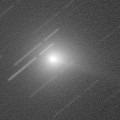
|
New bright comet. Now it is 8.3 mag (Apr. 21, Marco Goiato). It is expected to brighten up to 6 mag in May. In the Southern Hemisphere, it keeps observable in good condition until late June. In the Northern Hemisphere, it keeps unobservable until September when the comet will be fainter than 13 mag. It must have been observable at 16 mag in good condition in 2014 autumn, but it was not discovered.
Date(TT) R.A. (2000) Decl. Delta r Elong. m1 Best Time(A, h)
Apr. 25 22 52.56 -23 27.0 0.891 0.955 60 8.0 5:06 (271, 42)
May 2 23 48.24 -29 14.5 0.665 0.886 59 7.1 5:10 (281, 40)
|

|
It brightened up to 3.7 mag and became a naked eye comet in mid January (Jan. 13, Marek Biely). Now it is fading. But it is bright as 7.2 mag still now (Apr. 22, Maik Meyer). In the Northern Hemisphere, it keeps observable all night until July when the comet will fade down to 13 mag. It is not observable in the Southern Hemisphere.
Date(TT) R.A. (2000) Decl. Delta r Elong. m1 Best Time(A, h)
Apr. 25 1 27.58 74 32.5 2.031 1.791 61 7.7 5:06 (199,-34)
May 2 1 28.39 77 22.1 2.090 1.860 62 8.1 5:10 (195,-33)
|
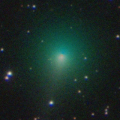
|
Now it is very bright as 9.2 mag (Apr. 21, Marco Goiato). In the Southern Hemisphere, it keeps observable in good condition for a long time until the comet fades out. In the Northern Hemisphere, it keeps extremely low and hard to observe until June. It will be observable in good condition after June while the comet will be fading gradually.
Date(TT) R.A. (2000) Decl. Delta r Elong. m1 Best Time(A, h)
Apr. 25 22 59.90 -9 56.4 1.742 1.374 52 8.7 5:06 (258, 33)
May 2 23 21.02 -7 53.6 1.733 1.388 53 8.7 5:10 (254, 34)
|
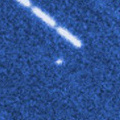
|
It brightened up to 12.8 mag until March (Mar. 21, Michael Mattiazzo). It will brighten up to 10.5 mag in May and June, but it is not observable. In the Northern Hemisphere, it will be observable after autumn while the comet will be fading.
Date(TT) R.A. (2000) Decl. Delta r Elong. m1 Best Time(A, h)
Apr. 25 2 46.21 6 13.1 2.377 1.406 11 11.1 18:49 ( 93, -7)
May 2 3 6.16 9 14.1 2.368 1.385 9 10.9 18:42 ( 96, -8)
|
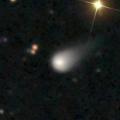
|
It brightened up to 13.6 mag until the end of 2014, brighter than originally expected (Dec. 19, Chris Wyatt). Now it is 12.7 mag (Apr. 19, Michael Mattiazzo). It is expected to brighten up to 4 mag from autumn to winter. It keeps observable in excellent condition until autumn in the Southern Hemisphere. In the Northern Hemisphere, it is hardly observable until December.
Date(TT) R.A. (2000) Decl. Delta r Elong. m1 Best Time(A, h)
Apr. 25 23 29.33 -21 57.9 3.715 3.201 52 11.4 5:06 (275, 34)
May 2 23 33.96 -22 17.9 3.533 3.118 57 11.2 5:10 (271, 39)
|
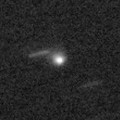
|
It will approach to the sun down to 0.3 a.u. in July, and it is expected to be bright. It brightened up to 15.6 mag in January (Jan. 13, Yasukazu Ikari). In the Southern Hemisphere, it keeps hard to observe for a while. But it will be observable after mid July, and keeps observable while the comet will be fading gradually. It will not be observable after this in the Northern Hemisphere.
Date(TT) R.A. (2000) Decl. Delta r Elong. m1 Best Time(A, h)
Apr. 25 0 59.31 2 23.0 2.564 1.656 20 11.7 5:06 (266, 2)
May 2 1 13.27 4 53.4 2.417 1.535 22 11.3 5:10 (261, 4)
|
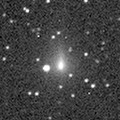
|
Bright new comet. Now it is bright as 11.2 mag (Apr. 25, Marek Biely). However, it is getting diffuse rapidly. It seems to be a fragment of Comets C/1988 A1 (Liller) and C/1996 Q1 (Tabur). It must have been visible bright in the evening sky from December to February in the Northern Hemisphere, but it was not discovered. It will be fading after this. But it is observable in excellent condition in the Northern Hemisphere. In the Southern Hemisphere, it is not observable until June.
Date(TT) R.A. (2000) Decl. Delta r Elong. m1 Best Time(A, h)
Apr. 25 1 23.35 82 57.8 1.059 1.187 70 11.4 5:06 (189,-35)
May 2 9 29.99 84 32.5 1.056 1.274 76 11.7 19:06 (180,-29)
|
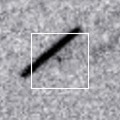
|
It will brighten up to 11 mag in April and May. But the condition is bad in this apparition. In the Southern Hemisphere, it is getting higher gradually in the morning sky. It will not be observable until late July in the Northern Hemisphere.
Date(TT) R.A. (2000) Decl. Delta r Elong. m1 Best Time(A, h)
Apr. 25 0 51.81 -2 32.4 2.348 1.491 24 11.4 5:06 (269, 6)
May 2 1 12.21 -1 20.6 2.362 1.525 26 11.4 5:10 (266, 8)
|
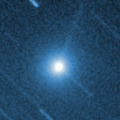
|
New bright comet. Now it is 10.4 mag (Apr. 24, Marek Biely). In the Northern Hemisphere, it is getting higher in the evening sky. But it will fade out rapidly after this. It is not observable in the Southern Hemisphere.
Date(TT) R.A. (2000) Decl. Delta r Elong. m1 Best Time(A, h)
Apr. 25 4 54.31 52 16.7 0.774 0.800 51 11.5 18:49 (147,-12)
May 2 6 17.84 48 28.5 0.989 0.941 56 12.7 18:42 (152, -2)
|
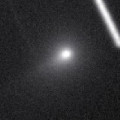
|
It brightened up to 9.2 mag in March (Mar. 9, Juan Jose Gonzalez). Now it is fading, but it is bright as 11.7 mag still now (Apr. 23, Piotr Guzik). In the Northern Hemisphere, it will be getting higher gradually after this. It is not observable after this in the Southern Hemisphere.
Date(TT) R.A. (2000) Decl. Delta r Elong. m1 Best Time(A, h)
Apr. 25 1 32.39 42 3.6 1.976 1.216 30 13.0 5:06 (235,-25)
May 2 1 37.40 46 56.0 2.026 1.316 33 13.6 5:10 (228,-23)
|
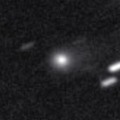
|
Now it is 14.9 mag (Apr. 1, Taras Prystavski). In 2015, it keeps 13-14 mag and will be observable in good condition for a long time.
Date(TT) R.A. (2000) Decl. Delta r Elong. m1 Best Time(A, h)
Apr. 25 19 17.65 -9 57.0 3.071 3.461 104 13.3 5:06 (181, 65)
May 2 19 21.45 -9 34.3 2.988 3.465 110 13.3 4:44 (180, 65)
|

|
Now it is so faint as 17.1 mag (Apr. 17, A. Maury, J.-F. Soulier, T. Noel, J.-G. Bosch).
Date(TT) R.A. (2000) Decl. Delta r Elong. m1 Best Time(A, h)
Apr. 25 17 57.38 -31 35.2 5.424 6.049 124 13.5 3:48 (180, 87)
May 2 17 56.15 -31 40.0 5.334 6.047 131 13.5 3:19 (180, 87)
|
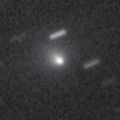
|
Now it is 15.2 mag and visible visually (Mar. 18, Sandor Szabo). It will brighten up to 11 mag in 2015 autumn. In this apparition, it is observable until the highlight while the comet is brightening.
Date(TT) R.A. (2000) Decl. Delta r Elong. m1 Best Time(A, h)
Apr. 25 12 34.19 4 41.6 1.396 2.326 150 13.7 22:21 (180, 50)
May 2 12 29.10 5 8.4 1.398 2.284 142 13.6 21:49 (180, 50)
|
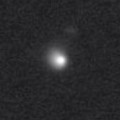
|
It brightened very rapidly. Now it is so bright as 14.6 mag and visible visually (Apr. 12, Sandor Szabo). It keeps 14-15 mag for a while after this. In the Northern Hemisphere, it will be getting lower gradually after May, and will be unobservable in mid June. In the Southern Hemisphere, it will be getting lower gradually after June, and will be unobservable in early August.
Date(TT) R.A. (2000) Decl. Delta r Elong. m1 Best Time(A, h)
Apr. 25 8 54.47 9 8.6 3.145 3.450 99 14.3 18:49 (178, 46)
May 2 8 58.69 8 48.3 3.234 3.444 93 14.3 18:42 (172, 46)
|

|
It brightened up to 6.9 mag in 2014 autumn (Oct. 17, Marco Goiato). Now it is fading. But it is bright as 12.6 mag still now (Feb. 9, Chris Wyatt). In the Southern Hemisphere, it had been unobservable temporarily for a while, but it will be observable in good condition again after this. It will be observable again in mid June also in the Northern Hemisphere.
Date(TT) R.A. (2000) Decl. Delta r Elong. m1 Best Time(A, h)
Apr. 25 0 47.16 -16 53.9 4.264 3.500 35 14.4 5:06 (280, 15)
May 2 0 49.59 -16 44.0 4.273 3.576 41 14.5 5:10 (276, 21)
|
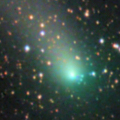
|
It brightened up to 9 mag from autumn to winter in 2014. Now it is fading rapidly. It has already faded down to 14.2 mag (Apr. 11, Yasukazu Ikari). In the Northern Hemisphere, it will be observable in excellent condition after this while the comet will be fading. In the Southern Hemisphere, it is hardly observable after this.
Date(TT) R.A. (2000) Decl. Delta r Elong. m1 Best Time(A, h)
Apr. 25 15 42.04 55 22.3 2.310 2.802 108 14.9 1:34 (180, 0)
May 2 15 10.57 56 36.1 2.400 2.874 107 15.2 0:35 (180, -2)
|
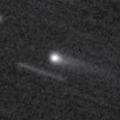
|
Now it is 15.5 mag (Apr. 15, J. Oey, P. Camilleri, H. Williams). It is expected to brighten up to 12 mag from July to August. In the Southern Hemisphere, it keeps observable in good condition until summer. In the Northern Hemisphere, it will be getting higher gradually after May, and will be observable in good condition after summer.
Date(TT) R.A. (2000) Decl. Delta r Elong. m1 Best Time(A, h)
Apr. 25 20 28.68 -39 17.7 1.855 2.175 94 15.2 5:06 (292, 75)
May 2 20 37.05 -37 21.3 1.721 2.121 98 14.9 5:10 (287, 80)
|
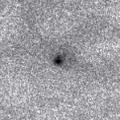
|
It must have brightened up to 11 mag from January to February, but no observations have been reported. Now it is 16.3 mag (Mar. 29, A. Maury, J.-F. Soulier, J.-G. Bosch, T. Noel). In the Southern Hemisphere, it is observable in the morning sky after this while the comet will be fading. In the Northern Hemisphere, it will be getting higher after July, but the comet will be faitner than 17 mag.
Date(TT) R.A. (2000) Decl. Delta r Elong. m1 Best Time(A, h)
Apr. 25 23 59.71 -14 41.6 2.190 1.594 42 15.0 5:06 (272, 24)
May 2 0 17.65 -13 44.7 2.202 1.643 44 15.1 5:10 (269, 26)
|
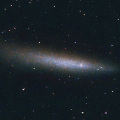
|
The spacecraft observed it brightened rapidly from 9 mag up to 2 mag when passing near by the sun. The nucleus has been already disintegrated, but the remnant was visible bright also on the earth (Mar. 7, Juan Jose Gonzalez). Now it is fainter than 10.3 mag (Mar. 17, Marek Biely). It locates high in the evening sky in the Northern Hemisphere. It is not observable in the Southern Hemisphere.
Date(TT) R.A. (2000) Decl. Delta r Elong. m1 Best Time(A, h)
Apr. 25 5 5.51 53 13.6 2.138 1.737 53 15.0 18:49 (149,-12)
May 2 5 28.67 53 27.1 2.321 1.863 51 15.5 18:42 (149,-12)
|
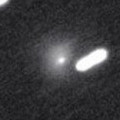
|
Very far object. However, outburst occured on Feb. 20, and it brightened up to 15 mag. It is bright as 15.8 mag still now (Mar. 28, Ken-ichi Kadota). It is reported so bright visually as 12.5 mag (Mar. 22, Marco Goiato). It locates high in the Southern Hemisphere. But it locates somewhat low in the Northern Hemisphere.
Date(TT) R.A. (2000) Decl. Delta r Elong. m1 Best Time(A, h)
Apr. 25 12 4.23 -21 57.5 8.265 9.143 149 15.2 21:52 (180, 77)
May 2 12 2.96 -21 36.7 8.312 9.142 143 15.2 21:23 (180, 77)
|
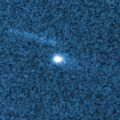
|
Now it is 16.4 mag (Apr. 22, Jean-Francois Soulier). It will brighten up to 11 mag from August to October. In the Northern Hemisphere, it will be getting higher gradually after July, then it keeps observable in good condition. In the Southern Hemisphere, it keeps low until November.
Date(TT) R.A. (2000) Decl. Delta r Elong. m1 Best Time(A, h)
Apr. 25 0 18.37 -2 48.9 2.563 1.784 31 15.5 5:06 (264, 13)
May 2 0 35.80 -0 48.8 2.482 1.732 33 15.2 5:10 (260, 15)
|
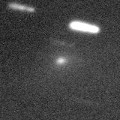
|
Now it is 15.3 mag (Mar. 28, Taras Prystavski). Distant object, but it keeps observable at 14-15 mag for a long time from 2015 to 2016.
Date(TT) R.A. (2000) Decl. Delta r Elong. m1 Best Time(A, h)
Apr. 25 21 16.40 -2 30.9 5.849 5.655 73 15.4 5:06 (228, 47)
May 2 21 19.88 -2 9.2 5.723 5.630 79 15.3 5:10 (218, 51)
|
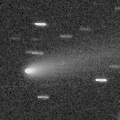
|
It brightened up to 13 mag in winter. Now it is fading, 15.2 mag (Apr. 12, Sandor Szabo). It keeps observable in good condition for a while.
Date(TT) R.A. (2000) Decl. Delta r Elong. m1 Best Time(A, h)
Apr. 25 11 12.27 17 58.6 1.856 2.587 126 15.3 21:00 (180, 37)
May 2 11 13.33 17 6.1 1.960 2.623 120 15.5 20:33 (180, 38)
|
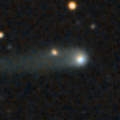
|
Now it is 15.3 mag (Jan. 7, Taras Prystavski). It keeps 15 mag for a long time from 2014 to 2015. It is observable in excellent condition in 2014 in the Southern Hemisphere, or in 2015 in the Northern Hemisphere. It becomes unobservable temporarily from March to May.
Date(TT) R.A. (2000) Decl. Delta r Elong. m1 Best Time(A, h)
Apr. 25 1 25.06 9 56.7 4.883 3.900 10 15.4 5:06 (263, -8)
May 2 1 30.71 11 27.6 4.865 3.906 15 15.4 5:10 (258, -3)
|

|
It brightened up to 11-12 mag in 2012. It has already faded down to 15.2 mag (Mar. 16, Taras Prystavski). It keeps observable at 15 mag in good condition until summer.
Date(TT) R.A. (2000) Decl. Delta r Elong. m1 Best Time(A, h)
Apr. 25 11 8.14 -5 56.3 8.622 9.361 135 15.4 20:55 (180, 61)
May 2 11 5.34 -5 34.2 8.748 9.399 127 15.4 20:25 (180, 61)
|

|
First return of a comet re-discovered after 112-year blank in 2008. It brightened up to 12 mag in 2008. It is expected to brighten up to 15 mag from spring to summer in this apparition. It keeps locating low in the morning sky for a while.
Date(TT) R.A. (2000) Decl. Delta r Elong. m1 Best Time(A, h)
Apr. 25 23 12.08 2 22.2 2.092 1.550 44 15.5 5:06 (249, 23)
May 2 23 32.58 3 52.3 2.058 1.542 46 15.4 5:10 (246, 25)
|
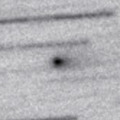
|
Now it is 16.0 mag recently (Apr. 17, A. Maury, J.-F. Soulier, T. Noel, J.-G. Bosch). In this apparition, it turns to approach to the sun down to 1.17 a.u., and it was expected to brighten up to 13 mag from March to May. But actually, it brightened up to 15.5 mag at best.
Date(TT) R.A. (2000) Decl. Delta r Elong. m1 Best Time(A, h)
Apr. 25 19 45.80 -15 7.9 0.469 1.172 98 15.5 5:06 (200, 69)
May 2 20 12.31 -13 30.5 0.473 1.177 98 15.6 5:10 (196, 68)
|

|
Now it is 14.7 mag (Apr. 1, Taras Prystavski). It is observable at 15-16 mag in good condition in 2015.
Date(TT) R.A. (2000) Decl. Delta r Elong. m1 Best Time(A, h)
Apr. 25 18 54.73 -19 9.5 7.230 7.653 111 15.6 4:45 (180, 74)
May 2 18 52.03 -19 30.9 7.147 7.682 118 15.6 4:15 (180, 74)
|
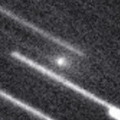
|
Now it is 14.7 mag (Apr. 8, C. W. Hergenrother). It approaches to the earth, and brightens up to 15-16 mag from April to May. But it will be fainter than 18 mag in late July. It is observable in excellent condition in the Southern Hemisphere. It will be observable in excellent condition after May also in the Northern Hemisphere.
Date(TT) R.A. (2000) Decl. Delta r Elong. m1 Best Time(A, h)
Apr. 25 20 53.96 -27 2.5 0.733 1.202 85 15.7 5:06 (256, 68)
May 2 21 13.22 -19 54.2 0.720 1.201 86 15.7 5:10 (237, 66)
|
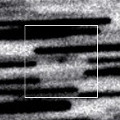
|
Now it is 16.6 mag (Apr. 1, Taras Prystavski). It is expected to brighten up to 15 mag in summer, and will be observable in excellent condition.
Date(TT) R.A. (2000) Decl. Delta r Elong. m1 Best Time(A, h)
Apr. 25 21 36.77 -11 20.2 1.782 1.747 71 15.8 5:06 (242, 50)
May 2 21 53.59 -9 50.6 1.723 1.739 73 15.7 5:10 (236, 52)
|
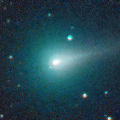
|
It brightened up to 10.6 mag from autumn to winter (Nov. 29, Seiichi Yoshida). Now it is 14.3 mag (Mar. 24, Taras Prystavski). It will be fading graudually after this. But it keeps observable for a long time until the comet fades out.
Date(TT) R.A. (2000) Decl. Delta r Elong. m1 Best Time(A, h)
Apr. 25 17 38.25 -14 41.1 1.776 2.534 129 15.7 3:29 (180, 70)
May 2 17 34.35 -14 45.8 1.780 2.607 136 15.9 2:58 (180, 70)
|
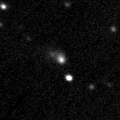
|
Now it is 14.8 mag and visible visually (Mar. 18, Sandor Szabo). It will pass close to the earth from spring to summer in 2016, and it is expected to be observable at 6-7 mag in good condition. It is already unobservable in the Southern Hemisphere. In the Northern Hemispehre, it will be getting lower gradually and will be unobservable temporarily in mid May.
Date(TT) R.A. (2000) Decl. Delta r Elong. m1 Best Time(A, h)
Apr. 25 4 48.84 33 24.0 5.329 4.629 41 15.8 18:49 (132, 0)
May 2 4 51.10 33 21.6 5.341 4.562 35 15.7 18:42 (129, -3)
|
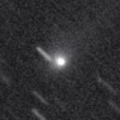
|
Now it is 14.8 mag (Mar. 21, Taras Prystavski). In the Northern Hemisphere, it keeps 15-16 mag and observable in excellent condition until early summer. It locates somewhat low in the Southern Hemisphere.
Date(TT) R.A. (2000) Decl. Delta r Elong. m1 Best Time(A, h)
Apr. 25 12 52.08 31 45.0 3.181 3.923 131 15.9 22:39 (180, 23)
May 2 12 48.13 30 41.2 3.256 3.951 127 16.0 22:08 (180, 24)
|

|
Now it is 17.6 mag (Apr. 17, A. Diepvens), fainter than predicted. It will brighten up to 13 mag in 2016. It will be getting lower after this, and will be unobservable in early June.
Date(TT) R.A. (2000) Decl. Delta r Elong. m1 Best Time(A, h)
Apr. 25 6 32.41 26 28.3 3.100 2.791 63 16.1 18:49 (145, 19)
May 2 6 42.19 26 14.0 3.157 2.766 58 16.0 18:42 (143, 18)
|
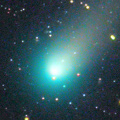
|
It brightened rapidly in outburst in mid October in 2013, then it keeps bright as 8-10 mag for a long time until 2014 summer. Now it is fading. It has already faded down to 15.8 mag (Feb. 9, Taras Prystavski). In the Southern Hemisphere, it keeps observable in good condition for a long time after this until the comet fades out. It is not observable in the Northern Hemisphere.
Date(TT) R.A. (2000) Decl. Delta r Elong. m1 Best Time(A, h)
Apr. 25 0 53.49 -31 51.7 5.701 5.087 48 16.6 5:06 (294, 22)
May 2 1 0.09 -31 47.9 5.706 5.149 52 16.7 5:10 (292, 27)
|
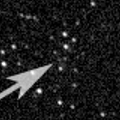
|
It brightened rapidly. Now it is 16.0 mag, much brighter than origianlly predicted (Mar. 28, Taras Prystavski). However, it will fade out rapidly after this.
Date(TT) R.A. (2000) Decl. Delta r Elong. m1 Best Time(A, h)
Apr. 25 16 24.28 -32 26.5 0.892 1.802 143 16.6 2:15 (180, 87)
May 2 16 21.73 -33 39.6 0.903 1.843 149 16.9 1:45 (180, 89)
|
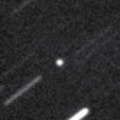
|
Now it is 16.7 mag (Apr. 19, J. Gonzalez). It keeps observable after this while the comet will be getting brighter graudually. It will brighten up to 11 mag from autumn to winter. But it locates low at that time.
Date(TT) R.A. (2000) Decl. Delta r Elong. m1 Best Time(A, h)
Apr. 25 14 37.39 6 10.1 1.409 2.377 159 16.8 0:29 (180, 49)
May 2 14 30.48 6 54.2 1.369 2.334 157 16.7 23:49 (180, 48)
|

|
It has not been observed yet in this apparition. But it must have already brightened up to 17 mag. It will be observable at 13 mag in good condition from summer to autumn.
Date(TT) R.A. (2000) Decl. Delta r Elong. m1 Best Time(A, h)
Apr. 25 21 59.37 -15 22.4 2.140 1.990 67 17.1 5:06 (252, 48)
May 2 22 15.32 -14 14.3 2.048 1.958 70 16.8 5:10 (247, 51)
|
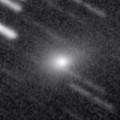
|
It brightened up to 13.8 mag in winter (Feb. 15, Jakub Cerny). Now it is fading. It has already faded down to 16.8 mag (Apr. 11, N. Yanes). It will be getting lower after May. It will be unobservable in June in the Northern Hemisphere, or in July in the Southern Hemisphere.
Date(TT) R.A. (2000) Decl. Delta r Elong. m1 Best Time(A, h)
Apr. 25 7 19.67 17 34.7 2.670 2.594 74 16.8 18:49 (151, 32)
May 2 7 29.57 17 2.9 2.765 2.607 70 17.0 18:42 (148, 32)
|
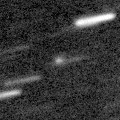
|
Now it is 17.7 mag (Feb. 17, K. Hills). It keeps observable at 17 mag from spring to summer. It locates somewhat low in the Northern Hemisphere.
Date(TT) R.A. (2000) Decl. Delta r Elong. m1 Best Time(A, h)
Apr. 25 17 19.90 -28 49.9 2.384 3.155 132 16.9 3:11 (180, 84)
May 2 17 18.50 -28 39.3 2.321 3.159 139 16.8 2:42 (180, 84)
|
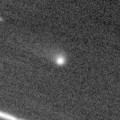
|
Now it is 16.3 mag (Apr. 19, Catalina Sky Survey). It keeps 17 mag for a long time from 2014 to 2016.
Date(TT) R.A. (2000) Decl. Delta r Elong. m1 Best Time(A, h)
Apr. 25 11 13.78 -19 42.8 4.602 5.389 137 16.8 21:01 (180, 75)
May 2 11 6.39 -18 55.1 4.691 5.397 130 16.9 20:26 (180, 74)
|
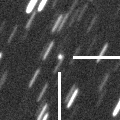
|
Brightened rapidly, and it kept brightening even after the perihelion passage. It brightened up to 15.8 mag and visible visually in March (Mar. 18, Sandor Szabo). But it will be fading after this. Now it is 16.8 mag (Apr. 17, T. Linder, R. Holmes). It is observable in excellent condition in the Northern Hemisphere. It is not observable in the Southern Hemisphere.
Date(TT) R.A. (2000) Decl. Delta r Elong. m1 Best Time(A, h)
Apr. 25 8 14.86 47 47.1 2.039 2.138 81 16.9 18:49 (172, 7)
May 2 8 32.80 46 13.1 2.134 2.176 78 17.0 18:42 (172, 8)
|
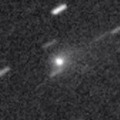
|
It Brightened up to 15.2 mag and visible visually in March (Mar. 18, Sandor Szabo). Now it is fading. It has already faded down to 17.0 mag (Apr. 18, E. Bryssinck). It keeps observable in good condition for a while.
Date(TT) R.A. (2000) Decl. Delta r Elong. m1 Best Time(A, h)
Apr. 25 11 46.78 11 35.0 1.644 2.479 137 17.0 21:34 (180, 44)
May 2 11 46.61 11 19.1 1.732 2.508 130 17.1 21:07 (180, 44)
|

|
Now it is 18.3 mag (Apr. 19, Mt. Lemmon Survey). It will brighten rapidly, and will be observable at 16.5 mag in good condition from May to July.
Date(TT) R.A. (2000) Decl. Delta r Elong. m1 Best Time(A, h)
Apr. 25 16 30.85 -21 9.7 0.978 1.891 144 17.2 2:21 (180, 76)
May 2 16 32.45 -19 54.1 0.921 1.870 151 17.0 1:56 (180, 75)
|
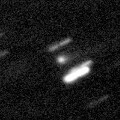
|
Now it is 16.7 mag (Apr. 14, Palomar Transient Factory). It keeps observable at 16-17 mag in good condition for a while.
Date(TT) R.A. (2000) Decl. Delta r Elong. m1 Best Time(A, h)
Apr. 25 8 6.51 13 59.7 4.118 4.180 86 17.1 18:49 (163, 39)
May 2 8 11.09 13 51.6 4.228 4.188 80 17.2 18:42 (158, 38)
|
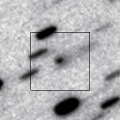
|
Now it is 17.2 mag (Mar. 24, iTelescope Observatory, Siding Spring). It keeps 17 mag until July. It is observable in excellent condition in the Southern Hemisphere. It locates somewhat low in the Northern Hemisphere.
Date(TT) R.A. (2000) Decl. Delta r Elong. m1 Best Time(A, h)
Apr. 25 16 46.05 -23 42.0 1.689 2.552 141 17.2 2:37 (180, 79)
May 2 16 43.74 -23 48.7 1.642 2.555 148 17.2 2:07 (180, 79)
|

|
First return of a periodic comet discovered in 1994. Now it is 17.5 mag (Mar. 23, iTelescope Observatory, Siding Spring). It will brighten up to 15 mag from summer to autumn, and will be observable in excellent condition in the Southern Hemisphere. It locates somewhat low in the Northern Hemisphere.
Date(TT) R.A. (2000) Decl. Delta r Elong. m1 Best Time(A, h)
Apr. 25 21 38.20 -32 35.5 2.943 2.919 78 17.3 5:06 (276, 60)
May 2 21 49.00 -32 23.8 2.829 2.887 83 17.2 5:10 (273, 65)
|
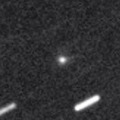
|
Now it is 17.4 mag (Apr. 15, Catalina Sky Survey). It will brighten up to 14 mag and will be observable in good condition in 2016.
Date(TT) R.A. (2000) Decl. Delta r Elong. m1 Best Time(A, h)
Apr. 25 12 39.26 2 41.1 2.771 3.696 152 17.3 22:26 (180, 52)
May 2 12 35.77 3 4.1 2.787 3.661 145 17.3 21:55 (180, 52)
|

|
It has not been observed yet in this apparition. But it must have already brightened up to 17 mag. It will be observable at 15 mag in good condition in autumn.
Date(TT) R.A. (2000) Decl. Delta r Elong. m1 Best Time(A, h)
Apr. 25 23 10.48 -4 3.4 2.998 2.430 47 17.4 5:06 (254, 28)
May 2 23 22.79 -2 55.0 2.913 2.406 50 17.3 5:10 (250, 31)
|
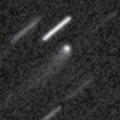
|
Now it is 17.4 mag (Apr. 14, A. Klotz, F. Kugel, J. Nicolas, C. Rinner). It keeps observable at 17-18 mag for a long time from 2013 to 2016. It keeps locating high in the Northern Hemisphere. It keeps locating very low in the Southern Hemipshere.
Date(TT) R.A. (2000) Decl. Delta r Elong. m1 Best Time(A, h)
Apr. 25 16 34.98 63 49.4 6.459 6.678 98 17.3 2:25 (180, -9)
May 2 16 22.07 64 38.8 6.481 6.690 97 17.3 1:45 (180,-10)
|
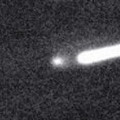
|
It brightened up to 15.5 mag from autumn to winter (Nov. 25, Taras Prystavski). Now it is fading. It has already faded down to 17.5 mag (Apr. 15, A. Diepvens). It keeps observable in good condition for a while.
Date(TT) R.A. (2000) Decl. Delta r Elong. m1 Best Time(A, h)
Apr. 25 17 59.12 -8 36.2 1.689 2.393 123 17.3 3:50 (180, 64)
May 2 17 58.38 -8 21.9 1.663 2.434 129 17.4 3:21 (180, 63)
|

|
Now it is 17.9 mag (Mar. 21, W. Hasubick). It was observed at 17 mag in 2014 summer. In the Northern Hemisphere, it is observable at 17.5 mag in excellent condition also in 2015. It is not observable in the Southern Hemisphere.
Date(TT) R.A. (2000) Decl. Delta r Elong. m1 Best Time(A, h)
Apr. 25 21 38.46 44 44.7 4.423 4.099 64 17.4 5:06 (204, 4)
May 2 21 46.17 45 51.8 4.412 4.120 66 17.4 5:10 (200, 5)
|
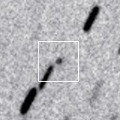
|
Now it is 17.5 mag (Apr. 21, T. H. Bressi, R. A. Mastaler). It keeps 17 mag until summer.
Date(TT) R.A. (2000) Decl. Delta r Elong. m1 Best Time(A, h)
Apr. 25 21 30.88 6 42.0 2.084 1.952 68 17.5 5:06 (224, 37)
May 2 21 21.81 9 43.3 1.942 1.963 76 17.4 5:10 (211, 40)
|

|
First return of a periodic comet discovered in 2008. Now it is 19 mag (Apr. 5, WISE). It will approach to the earth from spring to summer, and brighten rapidly. It will brighten up to 16 mag, and will be observable in good condition.
Date(TT) R.A. (2000) Decl. Delta r Elong. m1 Best Time(A, h)
Apr. 25 20 9.26 -8 9.8 1.038 1.465 91 18.0 5:06 (208, 60)
May 2 20 34.89 -7 43.3 0.964 1.418 91 17.7 5:10 (204, 61)
|
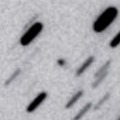
|
Now it is 17.0 mag (Apr. 1, Catalina Sky Survey). It was observed around 17-18 mag in early 2014. It will be observable around 17-18 mag again from 2014 autumn to 2015 spring, in excellent condition in the Northern Hemisphere. It is not observable in the Southern Hemisphere.
Date(TT) R.A. (2000) Decl. Delta r Elong. m1 Best Time(A, h)
Apr. 25 9 51.21 49 6.9 5.093 5.297 96 17.8 19:39 (180, 6)
May 2 9 52.16 47 53.9 5.193 5.311 91 17.8 19:13 (180, 7)
|
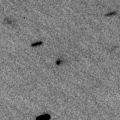
|
Now it is 17.9 mag (Apr. 8, A. Diepvens). Now it is around the aphelion. In the Northern Hemisphere, it is observable at 18 mag in good condition from winter to spring. It locates somewhat low in the Southern Hemisphere.
Date(TT) R.A. (2000) Decl. Delta r Elong. m1 Best Time(A, h)
Apr. 25 8 33.53 28 4.9 4.390 4.494 89 17.8 18:49 (173, 27)
May 2 8 36.31 27 43.8 4.486 4.483 83 17.9 18:42 (169, 26)
|
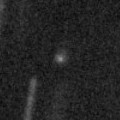
|
Now it is 17.8 mag (Mar. 29, K. Hills). It keeps observable at 17 mag from winter to spring. It is observable in excellent condition in the Southern Hemisphere. But it locates somewhat low in the Northern Hemisphere.
Date(TT) R.A. (2000) Decl. Delta r Elong. m1 Best Time(A, h)
Apr. 25 10 8.06 -32 5.4 2.455 3.109 122 17.9 19:55 (180, 87)
May 2 10 4.84 -32 15.7 2.529 3.117 116 18.0 19:25 (180, 87)
|
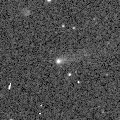
|
It had been observed at 15 mag for a long time from 2013 to 2014. Now it is fading. It will be observable at 18 mag in good condition from spring to summer. It locates somewhat low in the Northern Hemisphere.
Date(TT) R.A. (2000) Decl. Delta r Elong. m1 Best Time(A, h)
Apr. 25 19 35.01 -29 2.5 4.760 5.088 103 18.0 5:06 (216, 83)
May 2 19 36.09 -29 12.3 4.677 5.109 109 17.9 4:59 (180, 84)
|
|
![]()
 218P/LINEAR
218P/LINEAR C/2010 S1 ( LINEAR )
C/2010 S1 ( LINEAR ) C/2015 F2 ( Polonia )
C/2015 F2 ( Polonia ) 57P/du Toit-Neujmin-Delporte
57P/du Toit-Neujmin-Delporte C/2014 R1 ( Borisov )
C/2014 R1 ( Borisov ) C/2013 X1 ( PanSTARRS )
C/2013 X1 ( PanSTARRS ) C/2013 V2 ( Borisov )
C/2013 V2 ( Borisov ) 116P/Wild 4
116P/Wild 4 C/2012 X1 ( LINEAR )
C/2012 X1 ( LINEAR ) C/2014 W9 ( PanSTARRS )
C/2014 W9 ( PanSTARRS ) 10P/Tempel 2
10P/Tempel 2 51P/Harrington
51P/Harrington 110P/Hartley 3
110P/Hartley 3 299P/2014 D2 ( Catalina-PanSTARRS )
299P/2014 D2 ( Catalina-PanSTARRS ) C/2013 G9 ( Tenagra )
C/2013 G9 ( Tenagra ) P/2014 X1 ( Elenin )
P/2014 X1 ( Elenin ) 70P/Kojima
70P/Kojima 221P/LINEAR
221P/LINEAR 269P/2012 R2 ( Jedicke )
269P/2012 R2 ( Jedicke ) P/2015 F1 ( PanSTARRS )
P/2015 F1 ( PanSTARRS ) 318P/2014 M6 ( McNaught-Hartley )
318P/2014 M6 ( McNaught-Hartley ) 53P/Van Biesbroeck
53P/Van Biesbroeck 61P/Shajn-Schaldach
61P/Shajn-Schaldach C/2012 K8 ( Lemmon )
C/2012 K8 ( Lemmon ) 40P/Vaisala 1
40P/Vaisala 1 C/2013 G3 ( PanSTARRS )
C/2013 G3 ( PanSTARRS ) C/2015 H1 ( Bressi )
C/2015 H1 ( Bressi ) 319P/2015 G1 ( Catalina-McNaught )
319P/2015 G1 ( Catalina-McNaught ) C/2013 U2 ( Holvorcem )
C/2013 U2 ( Holvorcem ) 65P/Gunn
65P/Gunn C/2014 W6 ( Catalina )
C/2014 W6 ( Catalina ) P/2012 B1 ( PanSTARRS )
P/2012 B1 ( PanSTARRS )![]()


















































